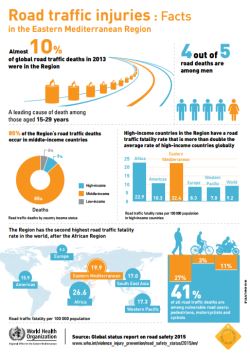 Road traffic injuries kill nearly 1.24 million people annuallyCairo, 14 March 2013 – The recently published Global status report on road safety reveals that road traffic crashes globally and in the Eastern Mediterranean Region remain a major public health concern. Despite some progress made in a number of countries, road traffic crashes continue to claim 1.24 million lives worldwide every year.
Road traffic injuries kill nearly 1.24 million people annuallyCairo, 14 March 2013 – The recently published Global status report on road safety reveals that road traffic crashes globally and in the Eastern Mediterranean Region remain a major public health concern. Despite some progress made in a number of countries, road traffic crashes continue to claim 1.24 million lives worldwide every year.
The report presents data from 182 countries across the world, including 19 countries of the Eastern Mediterranean Region. The Region is responsible for 10% of the world’s road traffic deaths with a fatality rate of 21.3 per 100 000 population, compared to a global rate of 18.03 per 100 000. The Region has the second highest rate after the African Region at 24.1 per 100 000.
Other findings warrant concern. Some countries of the Region have the highest road traffic fatality rates in the world, including the high-income countries whose fatality rates are 21.7 per 100 000 population; more than double the global rate for high-income countries at 8.7 per 100 000.
Males of the younger economically-productive age are hardest hit, with potentially significant implications for development due to lost productivity and income.
Vulnerable road users (pedestrians, cyclists and motorcyclists) account for 45% of road traffic deaths in the Region, clearly indicating the need for more attention to these groups. In addition, although the majority of countries have laws addressing the key risk factors (speeding, drink-driving and non-use of helmets, seat belts and child restraints), most legislation is neither comprehensive nor effective.
The report seeks to describe the road safety situation in participating countries and changes since the publication of the first global road status report in 2009. It highlights national gaps, and more importantly, serves as a baseline for monitoring action relating to the Decade of Action for Road Safety 2011–2020.
Between 2007 and 2010, 88 countries have managed to reduce the number of deaths on their roads, highlighting that prevention is possible through the implementation of effective interventions. The 2013 report is the second in a series looking into the implementation of specific road safety measures in different countries. These include action related to the risk factors; vehicle safety standards; road infrastructure inspections; policies on walking and cycling; and pre-hospital care systems. In addition, it provides information on national strategies with measurable targets to reduce deaths and injuries on the roads.
With this wealth of information in hand, it is hoped that evidence-based action at country level will be accelerated to meet the collective global target of the United Nations Decade of Action for Road Safety 2011–2020 of saving 5 million lives.
Related links


